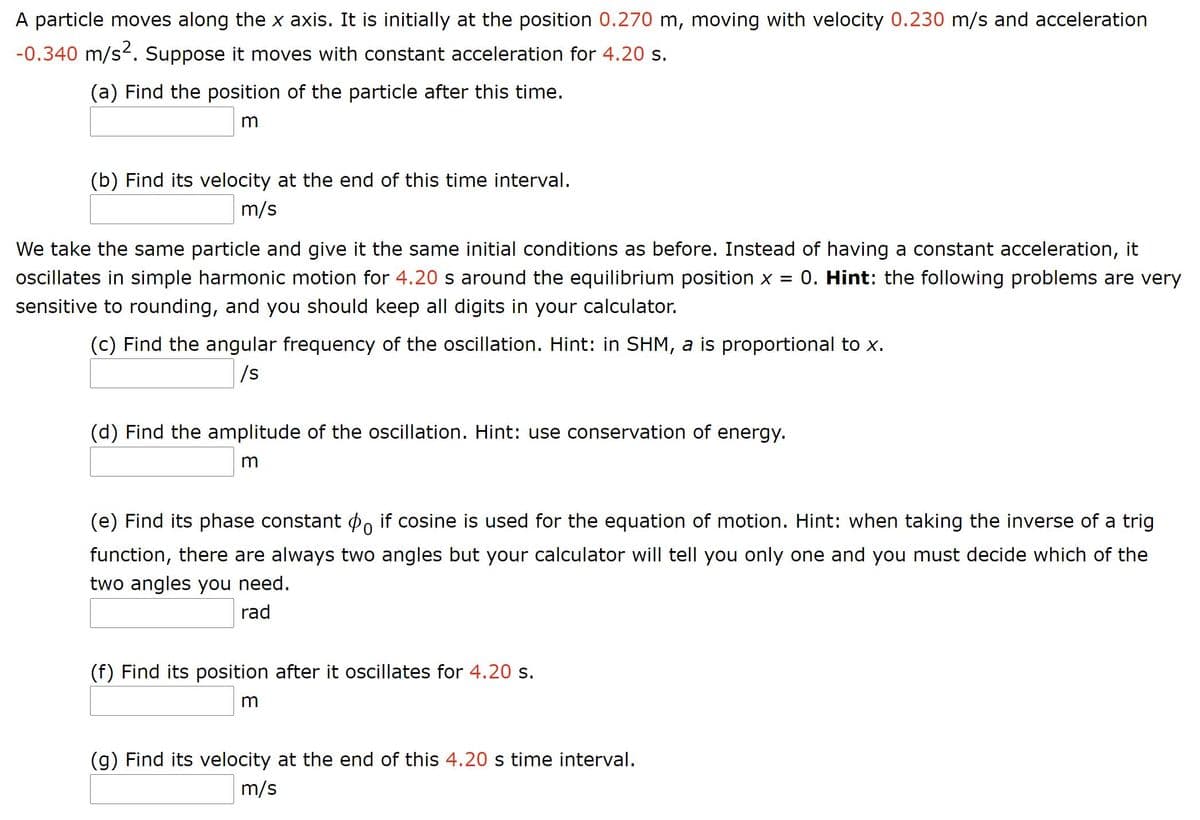A particle moves along the x axis. It is initially at the position 0.270 m, moving with velocity 0.230 m/s and acceleration -0.340 m/s2. Suppose it moves with constant acceleration for 4.20 s. (a) Find the position of the particle after this time. (b) Find its velocity at the end of this time interval. m/s
A particle moves along the x axis. It is initially at the position 0.270 m, moving with velocity 0.230 m/s and acceleration -0.340 m/s2. Suppose it moves with constant acceleration for 4.20 s. (a) Find the position of the particle after this time. (b) Find its velocity at the end of this time interval. m/s
Principles of Physics: A Calculus-Based Text
5th Edition
ISBN:9781133104261
Author:Raymond A. Serway, John W. Jewett
Publisher:Raymond A. Serway, John W. Jewett
Chapter2: Motion In One Dimension
Section: Chapter Questions
Problem 20P
Related questions
Question
100%
A to D question

Transcribed Image Text:A particle moves along the x axis. It is initially at the position 0.270 m, moving with velocity 0.230 m/s and acceleration
-0.340 m/s2. Suppose it moves with constant acceleration for 4.20 s.
(a) Find the position of the particle after this time.
m
(b) Find its velocity at the end of this time interval.
m/s
We take the same particle and give it the same initial conditions as before. Instead of having a constant acceleration, it
oscillates in simple harmonic motion for 4.20 s around the equilibrium position x =
0. Hint: the following problems are very
sensitive to rounding, and you should keep all digits in your calculator.
(c) Find the angular frequency of the oscillation. Hint: in SHM, a is proportional to x.
/s
(d) Find the amplitude of the oscillation. Hint: use conservation of energy.
(e) Find its phase constant Po if cosine is used for the equation of motion. Hint: when taking the inverse of a trig
function, there are always two angles but your calculator will tell you only one and you must decide which of the
two angles you need.
rad
(f) Find its position after it oscillates for 4.20 s.
(g) Find its velocity at the end of this 4.20 s time interval.
m/s
Expert Solution
Step 1
Note: Please send again the second part by mentioning to solve it by using the data of part 1 ( According to our guidelines)
Step by step
Solved in 2 steps with 1 images

Knowledge Booster
Learn more about
Need a deep-dive on the concept behind this application? Look no further. Learn more about this topic, physics and related others by exploring similar questions and additional content below.Recommended textbooks for you

Principles of Physics: A Calculus-Based Text
Physics
ISBN:
9781133104261
Author:
Raymond A. Serway, John W. Jewett
Publisher:
Cengage Learning

Principles of Physics: A Calculus-Based Text
Physics
ISBN:
9781133104261
Author:
Raymond A. Serway, John W. Jewett
Publisher:
Cengage Learning